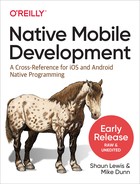Book Description
Learn how to make mobile native app development easier. If your team frequently works with both iOS and Android—or plans to transition from one to the other—this hands-on guide shows you how to perform the most common development tasks in each platform. Want to learn how to make network connections in iOS? Or how to work with a database in Android? This book has you covered.
In the book’s first part, authors Shaun Lewis and Mike Dunn from O’Reilly’s mobile engineering group provide a list of common, platform-agnostic tasks. The second part helps you create a bare-bones app in each platform, using the techniques from part one.
- Common file and database operations
- Network communication with remote APIs
- Application lifecycle
- Custom views and components
- Threading and asynchronous work
- Unit and integration tests
- Configuring, building, and running an app on a device
